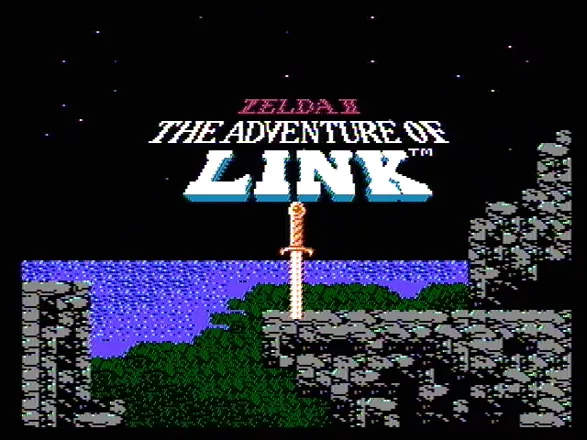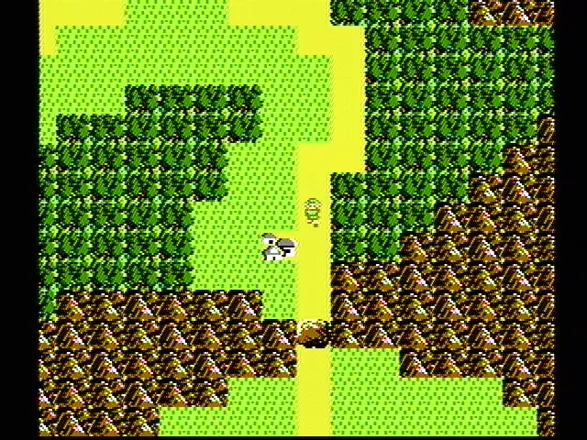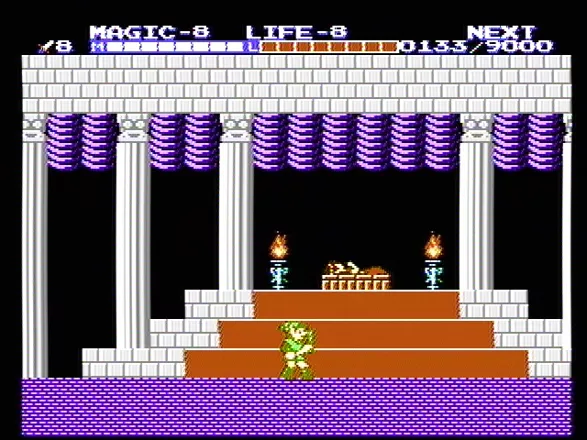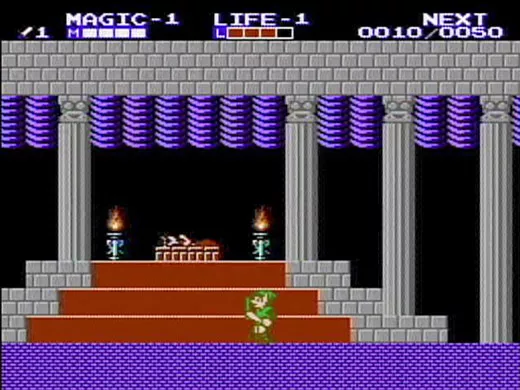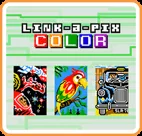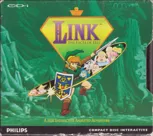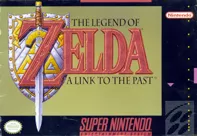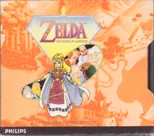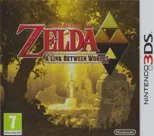Zelda II: The Adventure of Link
Description official descriptions
Link has just turned sixteen, and discovers a strange birthmark on his hand. With the help of Impa, Zelda's nursemaid, Link learns that this mark is the key to unlock a secret room where Princess Zelda lies sleeping. When young, Princess Zelda was given knowledge of the Triforce of power which was used to rule the kingdom of Hyrule, but when a magician unsuccessfully tried to find out about the Triforce from Zelda, he put her into an eternal sleep. In his grief, the prince placed Zelda in this room hoping she may wake some day. He ordered all female children in the royal household to be named Zelda from this point on, so the tragedy would not be forgotten. Now, to bring Princess Zelda back, Link must locate all the pieces of the Triforce which have been hidden throughout the land.
Each piece of the Triforce is in a temple guarded by a powerful monster which must be defeated. At the same time, Ganon's underlings are still around and gaining in strength and number. It is said Ganon could be brought back to life by sprinkling the blood of the one who defeated him on the ashes - which was Link himself.
Zelda II: The Adventure of Link is an action role-playing game, and a sequel to The Legend Of Zelda. The gameplay alternates between a top-down view (when traveling the land) and side-scrolling perspectives (when fighting, in a temple, or town). In the top-down view, Link cannot do much except for walking: in the side-scrolling action view, however, he can fight, cast spells, collect items and talk to people.
When Link encounters an enemy in the wilderness, or enters a location which contains enemies, he can fight them with his sword. If Link is at full health, his sword can be thrown, but when he is hurt, he can only fight in melee. Link has a shield which protects him against some of the enemies' attacks if they strike the shield. Touching an enemy or getting hit by their attacks decreases Link's health. If he runs out of health, he loses a life. If he loses all his lives, it's Game Over. Link can replenish his health completely by encountering a fairy in the wilderness, or by using the services of a healer in a town.
Link also has a "magic" meter. He can cast spells (as long as he has learned them) if he has some magic power left. Spells cost a various amount of magic power. They have various effects: they cure Link, allow him to jump very high, shoot fireballs etc. The magic power meter can be refilled by collecting blue and red jars sometimes left behind by enemies.
When Link slays an enemy, it might leave behind an item, or give Link some experience. When Link gains enough experience, he gains a level, which allows him to buy weapon power, maximum magic, or maximum health upgrades for his experience points. The player can also decide not to buy anything and stockpile his experience points for later use.
There are some items to be found that are necessary to get past certain points in the game. The Adventure of Link features a battery backup so games can be saved without needing a password system.
Spellings
- リンクの冒険 - Japanese spelling
Groups +
Screenshots
Promos
Videos
Add Trailer or Gameplay Video +1 point
See any errors or missing info for this game?
You can submit a correction, contribute trivia, add to a game group, add a related site or alternate title.
Credits (NES version)
10 People
| Executive Producer | |
| Producer |
|
| Director |
|
| Designer |
|
| Sound Composer |
|
| Programmer |
|
| Director |
|
Reviews
Critics
Average score: 77% (based on 52 ratings)
Players
Average score: 3.4 out of 5 (based on 185 ratings with 11 reviews)
Clearly a separate WIP title with Zelda IP added in late development
The Good
Ever play Cadash? That's a great game. This is a passable Cadash that predates it by about a year, on an 8-bit system!
The gameplay, as previously mentioned, is sidescrolling, with an overland map interlude for getting from place to place. There isn't much else good to be said about this game, though. It is primitive at best, and is stuck somewhere between Phantasy Star and Cadash, without the horsepower in the NES to pull it off properly.
This kind of side scrolling RPG would become very common in the future. What Zelda 2 has going for it is that it is innovative, it's too bad Nintendo didn't release it with its original characters instead of adding a "touch of Zelda" when the real Zelda 2, which I'm convinced was scrapped, didn't work out.
The Bad
Remember Mario 2? Remember the story of how they took a game that was not Mario and overlaid a bunch of Mario sprites to make a funky game that didn't feel right?
I suspect that isn't the only time Nintendo made that mistake. They did it with Zelda, too.
What you have is a game that was clearly not designed as a Zelda title with Zelda sprites and the first 5 seconds of the overland theme grafted on to make it appear "Zeldaish."
The Zelda overland theme, the really cool one that sticks in your head, plays for about 5 seconds and then immediately and rather crudely dissolves into cheesy uninspired 8-bit kazoo box music. That progression in the music describes the rest of the game. 5 seconds of Zelda and 15 hours of some other game that the box lied about. As you go, it just becomes wildly less and less like Zelda until you start wondering how Link got so tall.
Give me a map, or a compass, or rupees or ANYTHING else from the original game and this criticism becomes invalid, but it isn't there. There's no "nightmare key," no master sword, no heart meter. You can't make a "departure" sequel and ditch nearly everything that made the flavour of the original.
This was the 80's, back when they were plastering Erno Rubik's name on every dumb puzzle they could find, yet none of them were "the cube." This kind of "Brand leveraging" proved to be very damaging to the companies that did it, and so you don't see nearly as much of it any more. Nintendo learned and now jealously guards its brands.
The Bottom Line
Zelda sprites added to a perfectly good RPG to increase sales.
You can play the original Zelda and it's all there, in crude form. Everything that would become the rest of the series.
This game doesn't represent a "departure" as so many apologists will tell you. It's a completely different game. It's very difficult, and by today's standard's not terribly innovative, but okay to play if you like a sidescrolling RPG like Cadash. It's amazing they pulled this off on the 8-bit NES.
So when you hear this game get badmouthed, it's mostly because of people who expected a Zelda title and didn't get one. It's Super Mario Bros. 2 all over again. The good news is that there is a title.
Remember, it predates Cadash by a year, is playing on 8-bit hardware, and is a perfectly good RPG.
(Just watch out for the guy who tells you to get the candle at the palace by going "West." The palace is to the NNE.)
Production standards have improved since these days...
(Reviewer played this off the Zelda Collector's Edition GC disc. There may have been a map showing exactly where the candle palace is in the original.)
NES · by Zaghadka (62) · 2006
The Good
This, I think, is the best Zelda game. It is the toughest of all Zelda games because you actually end up beating your shadow. I have 4 more Zelda games, and they took me weeks of once in a while play to finish them, but this one took me like 10 years, no kidding! (well, maybe because I got it when I was 5 ys. old, but EVERYONE in my family played it and no one could win it.) It requires thinking a lot, and understanding clues. NO tips and tricks from anywhere! It is an interesting story, and has the most original enemies and dungeons from all Zelda Games. I think is the perfect trama because you have to wake up Zelda, the original idea of the game; you don't go around for other objects that have nothing to do with Hyrule like the other Zelda Sequels. You definitely have to think a lot because there are things that have no clues actually, and without them you cannot move on, that is why it took me such a long time, cause i got stuck many times.
The Bad
It is the best game, no complaints, but the fact that you thumbs WILL HURT a lot, especially if you already fought with your shadow!
The Bottom Line
If you like adventure, Zelda games, and most of all best sellers with Nintendo;s Golden Seal, you WILL love this game!
NES · by cinthya gomez (2) · 2004
The Good
I like side-scrolling games such as Mega Man and Super Mario Brothers 3, so naturally, I'm going to enjoy a well-designed action game with well-balanced elements, and intense combat(for the most part). The graphics are quite good for a late 80's NES game, but they aren't the best on the system(crisis force comes to mind). The sound is not as great as it was in the original Zelda, but it's still solid nonetheless.
The Bad
Zelda 2's main problem is it's rather difficult game play, especially when it comes to combat. Remember when I said the combat is intense? This is the reason why. Enemies have difficulty patterns to follow, especially the Iron knuckles, Link's sword is WAY too damn short, and most of the magic is only used in certain situations.
Again I say, the music isn't as good as the original Zelda.
The Bottom Line
Zelda II is a underrated gem of a game that gets too much bashing just for being a lot different from the original one. It's a solid game that is recommended and very playable, but it's not without flaws, especially where the difficulty is involved. I own Zelda II on Zelda:Collectors Edition on Nintendo GameCube(I play it on my Wii, actually)and I think it's pretty good. One of the better games in the NES library.
***GOOD STUFF***
Really fun combat
Excellent mix of RPG elements
Decent music
***BAD STUFF***
Really freaking hard!!!!
Inferior music to the original
Overall, I give Zelda II:The Adventure Of LINK about..... 8.5 out of 10
NES · by JohnLennon224 (13) · 2009
Discussion
| Subject | By | Date |
|---|---|---|
| One of my favourite NES games so far, I easily prefer it to Zelda 1 | Andrew Fisher (697) | Mar 27, 2024 |
| So this is the black sheep?.. | Unicorn Lynx (181775) | May 30, 2012 |
| Only one who like this more than the first? | Simoneer (29) | Jun 15, 2010 |
Trivia
Cartridge
Zelda II: The Adventure of Link was the only other Nintendo-licensed NES title to have the honor of being a gold cartridge besides the original Legend of Zelda.
ERROR
Inside a house within one of the towns is an NPC who simply says "I AM ERROR" when talked to. While many gamers at first found this to be a mistake in the code, there is another NPC later in the game that tells you Error knows a secret, proving that Error is his name and not an error.
It is possible that Error’s name was originally "Errol" (like the Australian-American actor Errol Flynn), but due to the letters "R" and "L" being allophones in Japanese, the programmers mistyped the name as "Error" in translating the game to English.
Platforming
As of 2005 Zelda II is the only game in the series to use a standard jump button that doesn't require the use of a power-up, or running off the side of a ledge to clear a gap.
Town names
Many of the villages share their names with characters from Ocarina of Time (Ruto, Rauru, Mido and Saria, etc.)
Interestingly enough, Ocarina of Time is considered to be the first Zelda game continuity-wise, so it's possible the villages are named in their honour, at least in the case of the Sages (Rauru, etc.).
Awards
- Electronic Gaming Monthly
- November 1997 (Issue 100) - ranked #72 (Best 100 Games of All Time)
Information also contributed by CaptainCanuck and Mark Ennis
Analytics
Upgrade to MobyPro to view research rankings!
Related Sites +
-
Classic NES Series for the Game Boy Advance
Covers the line-up of the new Game Boy Advance series of NES Classics. -
Howard & Nester do The Adventure of Link
A regular feature in Nintendo Power magazine, Howard & Nester was a comic strip about two game whizzes who would one-up each other, while disclosing hints and tips, in the settings of various recently-released games for the NES platform. In the March/April 1989 two-page installment, they figure out how to extend the bridge in Saria. -
OC ReMix Game Profile
Fan remixes of music from Zelda II: The Adventure of Link. -
RPG Classics Zelda 2 shrine
Contains extensive information on this game, including descriptions of bosses, items, magics as well as maps and a walkthrough. -
Video review of Zelda II: The Adventure of Link
The Angry Video Game Nerd, James Rolfe, reviews Zelda II: The Adventure of Link on NES. -
Zeldapower.com Forums
Message Board for all of the Zelda games
Identifiers +
Contribute
Are you familiar with this game? Help document and preserve this entry in video game history! If your contribution is approved, you will earn points and be credited as a contributor.
Contributors to this Entry
Game added by Servo.
Nintendo 3DS added by ResidentHazard. Wii U added by Michael Cassidy. Nintendo Switch added by Kam1Kaz3NL77. Game Boy Advance, Wii added by gamewarrior.
Additional contributors: Satoshi Kunsai, Jeanne, Guy Chapman, NH, Alaka, monkeyislandgirl, Pseudo_Intellectual, LepricahnsGold, Perfil Falso, Patrick Bregger, Thomas Thompson.
Game added September 28, 2002. Last modified February 1, 2024.

